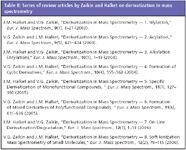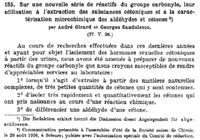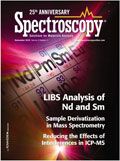Derivatization in Mass Spectrometry
Two disparate paths can lead to increased performance in mass spectrometric analysis. Improvements in fundamental parameters of instrument performance can be achieved through optimized interface design, improvements in ion source and analyzer efficiency, and enhanced detector performance. Increased performance also can be achieved through a better sampling protocol, or through better chromatographic performance. Alternatively, because we are clever chemists, we might choose to alter the chemical and physical characteristics of the sample itself, however collected, to achieve a more complete transport through the sample purification/selection/chromatographic process, and to achieve better ionization through enhanced sensitivity or selectivity. This second path involves a change in either the physical or chemical form of the sample. A change in the chemical form of the sample is sample derivatization, which is the focus of this column.

Two disparate paths can lead to increased performance in mass spectrometric analysis. Improvements in fundamental parameters of instrument performance can be achieved through optimized interface design, improvements in ion source and analyzer efficiency, and enhanced detector performance. Increased performance also can be achieved through a better sampling protocol, or through better chromatographic performance. Alternatively, because we are clever chemists, we might choose to alter the chemical and physical characteristics of the sample itself, however collected, to achieve a more complete transport through the sample purification/selection/chromatographic process, and to achieve better ionization through enhanced sensitivity or selectivity. This second path involves a change in either the physical or chemical form of the sample. A change in the chemical form of the sample is sample derivatization, which is the focus of this column.
Sample derivatization is a general term used for a chemical transformation designed to improve analytical capabilities, and it is a mainstay of analytical chemistry and instrumental analysis. The chemical structure of the sample can be modified to a form consistent with a better outcome for separation from other mixture components, or into a form that is more easily introduced to the measuring instrument, or into a chemical form that provides an enhanced response in terms of either improved selectivity or sensitivity. Derivatization reactions are chemical reactions. As such, there are many variables that control reaction completeness, speed, and specificity. These include temperature, solvents, catalysts, and supports. Each of these variables can be optimized within a specific application. Years of experience with widely used derivatization reactions have culminated in automated miniaturized kits available from a variety of commercial vendors. Websites of such vendors are populated with tables that describe such derivatization kits and application to certain functional groups, and provide examples of applications in chromatography and spectrometry. More complete information is found in monographs and handbooks (1,2). Mass spectrometry (MS) journals routinely contain reports of new derivatization reagents, and new uses for older reagents. Logically, much of the applications work is reported in the appropriate journals, and while derivatization may be an integral part of the procedure, it may not be highlighted as a search or indexing keyword.
Derivatization reactions used in MS often overlap with those used in other venues of analytical chemistry. However, there are some derivatization reactions specifically designed for MS, such as those that enhance ionization or introduce a specific mass shift to the sample ions that becomes evident in the mass spectrum. The general goals of derivatization in MS are outlined in Table I. Most of these goals should be self-explanatory, and they are, of course, not mutually exclusive. For instance, derivatization to create a new compound as a surrogate for the original almost always changes the physical and chemical properties of the compound (thereby changing the volatility and the thermal stability), almost always changes the mass, and usually affects the limits of detection that can be achieved. Constant demands for better selectivity and sensitivity in MS analysis, the use of a wide variety of different ionization methods, and the expanding areas of application of MS combine to ensure a steady stream of literature reports of new derivatization reagents or modifications of past procedures (search "novel derivatization" + "mass spectrometry" on the web). Reviews of new and more established reactions are especially valuable. Halket and Zaikin have published reviews of MS derivatization (3,4), and their series of reviews published in European Mass Spectrometry (Table II) is an excellent complement. Other recent reviews (5–10, for example) deal with specific ionization methods of focus on specific areas of application.

Table I: General goals of derivatization in mass spectrometry
Given the length of comprehensive reviews, clearly this column must focus on a limited aspect of MS derivatization. Many of the most established derivatization reactions were developed for use in gas chromatography–mass spectrometry (GC–MS) and electron ionization. Specifically, sample compounds that were not sufficiently volatile or stable to pass through the GC system were converted to more stable forms. As new ionization methods were developed, a shift in focus was apparent. For example, negative ion analysis was not widespread for analytical applications until chemical ionization sources were put in place. As the parallels between electron-capture detectors (used in GC) and negative ion MS became clear, derivatization reactions that modified the sample with an electrophoric (such as a pentafluorobenzyl derivative) group quickly appeared. When the first of the desorption ionization methods (fast atom bombardment [FAB] and liquid secondary ion mass spectrometry [LSIMS]) appeared in the late 1980s, and mass spectrometry–mass spectrometry (MS-MS) was accepted for analytical purposes, different forms of derivatization appeared. The observation (11) that precharged compounds usually exhibited a higher ionization efficiency in desorption ionization methods such as FAB soon generalized to electrospray ionization (ESI) and matrix assisted laser desorption ionization (MALDI) MS, although covariant factors relevant to sample transport in solid and liquid matrices soon became apparent. The ability of a localized charge to direct fragmentation both in the mass spectrum and in the MS-MS spectrum was also broadly recognized. Given this new direction in derivatizaton, the literature and the handbooks were consulted for chemical reactions that offered functional-group selectivity in the creation of a charged derivative. Some well-known name reactions showed an immediate applicability in MS analyses, and often, derivatization reactions were rediscovered by research groups working in widely divergent areas.

Table II: Series of review articles by Zaikin and Halket on derivatization in mass spectrometry
Derivatization reactions involving Girard's reagents are an example of one of the first reactions shown to be useful in desorption ionization MS, and the continued development over 25 years since the first report illustrates sometimes unanticipated twists and turns in development. These derivatization reagents were first described in 1936, and were called, at first, Girard–Sandulesco reagents in recognition of both authors on the original paper (12). Try your French with the first part of the paper shown in Figure 1. A historical review of the immediate impact of these reagents in separations is part of a larger paper by Cerruti (13), and the reagents became part of the complement of reagents widely used in analytical chemistry. In 1984, Ross and colleagues (14) used the Girard's reagent to transform samples adsorbed in charcoal and create a clearly observable signal in liquid SIMS, and the next year, the use of the reagent to derivatize ketosteroids for FAB MS was published (15).

Table II: Series of review articles by Zaikin and Halket on derivatization in mass spectrometry
There seems to be a pause in further developmental reports until Shackleton and colleagues (16) described the ESI mass spectra of Girard's derivatives of steroid esters in 1997. This work was expanded into MALDI-MS and MS-MS in just a few more years (17). In a parallel track, Naven and Harvey in 1996 showed that the Girard's derivatization was useful in improving the signal in the ESI and MALDI mass spectra from derivatized oligosaccharides (18). It was perhaps at this point that the true generality of this reagent began to be appreciated. For instance, use of the derivatization reagent in an ESI assay for the mutagenic 5-formyl-2'-deoxyuridine in cellular DNA has recently been described (19). Mirzaei and Regnier (20) used the derivatization reagent to react with oxidized proteins, enriching the products of the derivatization reaction on a strong cation exchange resin, and then identifying the site of the oxidation with ESI MS-MS.
Although the original Girard's reagents have the authority of 75 years of experience behind them, there is no reason to think that these structures as originally described are as optimally suited as MS derivatives. Accordingly, Johnson (21) has described a modified structure for the derivatization reagent that provides 3–7 times better signal levels in the ESI mass spectrum. Johnson also notes that the derivatives can be used for a generalized scanning of all aldehydes and ketones in a mixture (see Table I) through a constant neutral loss scan of 59 Da (trimethyl-amine) in MS-MS, and that this scan was used in a profiling screen of ketones, ketoacids, and ketodiacids in the urine of children with ketosis. DeBarber and colleagues (22) recently described a diagnostic application, ESI MS-MS quantification of 7α-hydroxy-4- cholesten-3-one as a test for cerebrotendinous xanthomatosis.
As we push limits of detection to lower and lower levels, distinguishing signal from noise becomes a major concern. Control of the isotopes in derivatization reagents is a not-so-secret weapon. Mirzaei and Regnier (23) have described the use of light- and heavy-isotope-labeled Girard's reagents to track protein carbonyls that are indicators of oxidative stress. Authentic signal appears in the mass spectrum as a doublet that reflects the doublet of the original derivatizing reagent, aiding in the elimination of false positives and improving quantitation.
The development of the Girard's derivatization reagents for MS is analogous to the development of several functional-group specific reaction schemes now in common use in MS, and especially ESI and MALDI. The early description and development of pyridinium derivatives of alcohols for MS analysis is a case in point. Based upon a reaction well-known in the organic chemistry literature (24, for example), the suitability of the derivative for MS using the desorption ionization method FAB is shown (25), the reaction generalized and explored (26), adapted to general areas of application (27), and ultimately becoming part of the recognized tools of analysis to the point where the reaction can be part of a forensic analysis (28).
Much of our strategy for MS derivatization links directly to the efficiency of sampling, separation, and ionization. Anderegg (29) reviewed the link between derivatization and controlling fragmentation in the mass spectrum. This potential for control, and the use of insightful isotopic coding in derivatization reagents, guarantee continued developments in derivatization for MS. Watch in 2036 for the centennial celebration of the use of Girard's reagents in analytical chemistry!

Kenneth L. Busch Kenneth L. Busch opines that an analogy exists between derivatization in mass spectrometry and transposition in music. The goal is to retain the fidelity of the (sample/music), but sometimes one has to modify the pitch to match the instrument available, and hopefully achieve a "better" result. As in music, the reported results are for the particular performance, and the concordance to the original composition always has to be carefully considered. Also, just like in music, sometimes the new perspective offers a different and unexpected insight. This column is the sole responsibility of the author, who can be reached at WyvernAssoc@yahoo.com
References
(1) D.R. Knapp, Handbook of Analytical Derivatization Reactions (John Wiley and Sons, New York, 1979).
(2) K. Blau and G.S. King, Handbook of Derivatives for Chomatography (Heyden, New York, 1978).
(3) V.G. Zaikin and J.M. Halket, Encyclopedia of Mass Spectrometry, Vol. 6 (Ionization Methods), M. Gross, Ed. (Elsevier, New York, 2007).
(4) J.M. Halket and V.G. Zaikin, Encyclopedia of Mass Spectrometry, Vol. 8 (Hyphenated Methods), W.M.A. Niessen, Ed. (Elsevier, New York, 2006).
(5) D.R. Knapp, Meth. Enzymol.193, 314–329 (1990).
(6) J.M.E. Quirke, C.L. Adams, and G.J. Van Berkel, Anal. Chem. 66, 1302–1315 (1994).
(7) J.M. Halket, D. Waterman, A.M. Przyborowska, R.K.P. Patel, P.D. Fraser, and P.M. Bramley, J. Exper. Botany56(410), 219–243 (2005).
(8) S. Gao, Z.-P. Zhang, and H.T. Karnes, J. Chromatogr., B825, 98–110 (2005).
(9) T. Santa, O.Y. Al-Dirbashi, and T. Fukushima, Drug Discov. Ther.1(2), 108–118 (2007).
(10) D.-L. Lin, S.M. Wang, C.-H. Wu, B.-G. Chen, and R.H. Liu, J. Food Drug. Anal.16(1), 1–10 (2008).
(11) K.L. Busch, S.E. Unger, A. Vincze, R.G. Cooks, and T. Keough, J. Amer. Chem. Soc.104, 1507–1510 (1982).
(12) A. Girard and G. Sandulesco, Helv. Chim. Acta 19, 1095–1107 (1936).
(13) L. Cerruti, Hyle – Int. J. Philosophy Chem.4(1), 39–61 (1998).
(14) M.M. Ross, D.A. Kidwell, and J.E. Campana, Anal. Chem. 56, 2142–2145 (1984).
(15) G.C. DiDonato and K.L. Busch, Biomed. Mass Spectrom.12, 364–366 (1985).
(16) C. H. L. Shackleton, H. Chuang, J. Kim, X. de la Torre, and J. Segura, Steroids62, 523–529 (1997).
(17) W.J. Griffiths, S. Liu, G. Alvelius, and J. Sjövall, Rapid Commun. Mass Spectrom.17, 924–935 (2003).
(18) T.J.P. Naven and D.J. Harvey, Rapid Commun. Mass Spectrom.10, 829–834 (1996).
(19) H. Hong and Y. Wang, Anal. Chem.79, 322–326 (2007).
(20) H. Mirzaei and F. Regnier, Anal. Chem. 78, 770–778 (2006).
(21) D.W. Johnson, Rapid. Commun. Mass Spectrom. 21, 2926–2932 (2007).
(22) A.E. DeBarber, W.E. Connor, A.S. Pappu, L.S. Merkens, and R.D. Steiner, Clin. Chim. Acta411(1–2), 43–49 (2010).
(23) H. Mirzaei and F. Regnier, J. Chromatogr., A1134, 122–133 (2006).
(24) K. Hojo and T. Mukaiyawa, Chem. Lett. 369-372 (1978).
(25) S.A. Testino, K.L. Busch, and J.N. Haseltine, Proc. ASMS Conf. Mass Spectrometry and Allied Topics, Washington, DC, May 31-June 5, 1992, pages 1539–1540.
(26) J.M.E Quirke and G.J. Van Berkel, J. Mass Spectrom. 36, 1294-1300 (2001).
(27) J.C. Dunphy, D.G. Pessler, S.W. Morrall, K.A. Evans, D.A. Robaugh, G. Fujimoto, and A. Negahban, Environ. Sci. Technol.25, 1223–1230 (2001).
(28) D. Thieme, H. Sachs, and M. Thevis, J. Mass Spectrom. 43, 974-979 (2008).
(29) R.G. Anderegg, Mass Spectrom. Rev.7(4) 395–424 (1988).

LIBS Illuminates the Hidden Health Risks of Indoor Welding and Soldering
April 23rd 2025A new dual-spectroscopy approach reveals real-time pollution threats in indoor workspaces. Chinese researchers have pioneered the use of laser-induced breakdown spectroscopy (LIBS) and aerosol mass spectrometry to uncover and monitor harmful heavy metal and dust emissions from soldering and welding in real-time. These complementary tools offer a fast, accurate means to evaluate air quality threats in industrial and indoor environments—where people spend most of their time.
NIR Spectroscopy Explored as Sustainable Approach to Detecting Bovine Mastitis
April 23rd 2025A new study published in Applied Food Research demonstrates that near-infrared spectroscopy (NIRS) can effectively detect subclinical bovine mastitis in milk, offering a fast, non-invasive method to guide targeted antibiotic treatment and support sustainable dairy practices.
Smarter Sensors, Cleaner Earth Using AI and IoT for Pollution Monitoring
April 22nd 2025A global research team has detailed how smart sensors, artificial intelligence (AI), machine learning, and Internet of Things (IoT) technologies are transforming the detection and management of environmental pollutants. Their comprehensive review highlights how spectroscopy and sensor networks are now key tools in real-time pollution tracking.